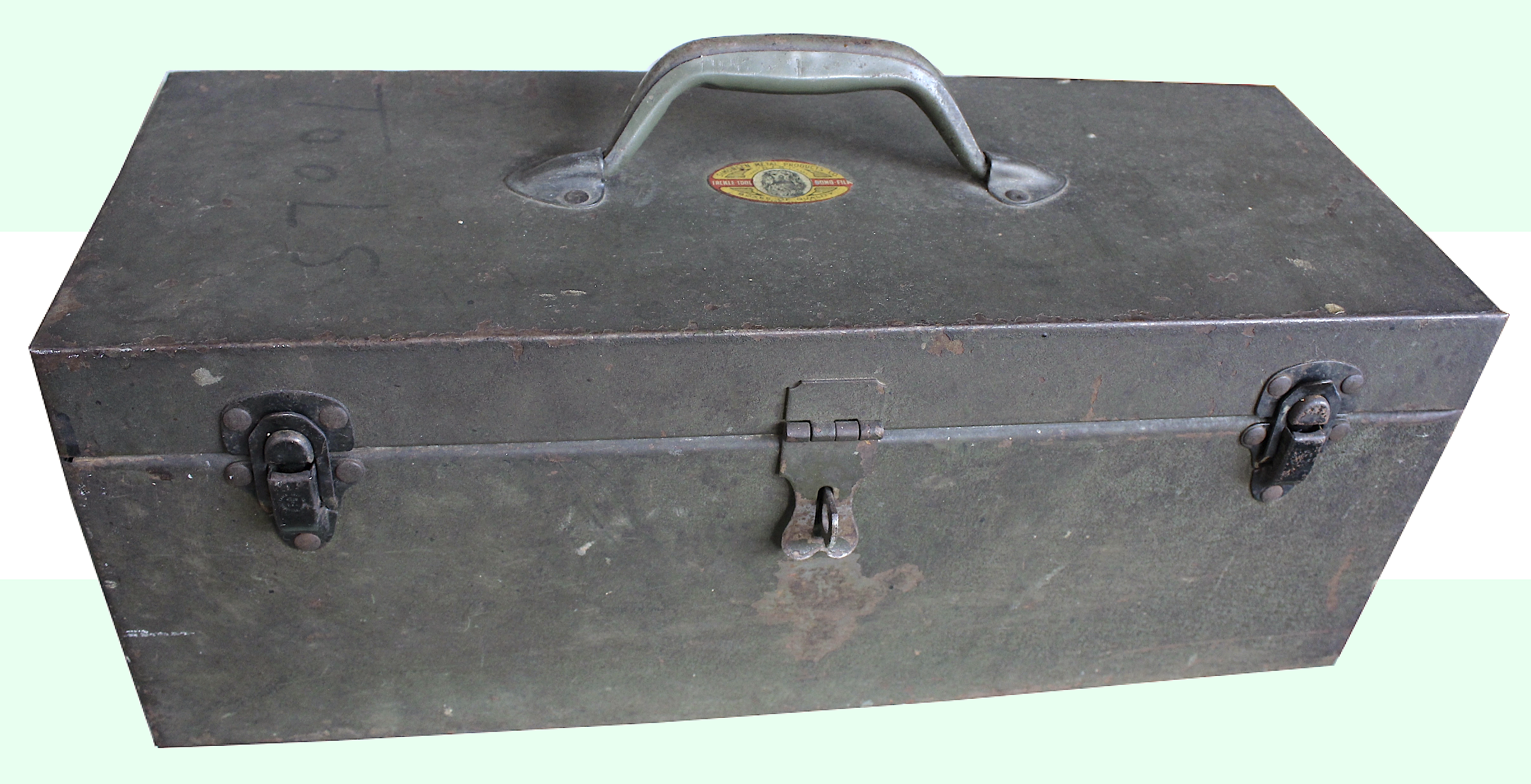
Museum Artifact: Simonsen Metal Toolbox / Tackle Box, c. 1950s
Made By: Simonsen Metal Products Co., 4444 W. Chicago Ave., Chicago, IL [Humboldt Park]
Edward H. Simonsen was born in Racine, Wisconsin, in 1891, the son of Danish immigrants. From there, his life unfolded in typical “American Dream” fashion—or at least that’s the nuts and bolts version we’re left to infer. He moved to Chicago in his youth, enlisted in World War I but was exempted for a “deformed knee,” married his sweetheart Ethel Stapp in 1920, and got a job at the R.M. Eddy Brass Foundry—eventually working his way up to superintendent.
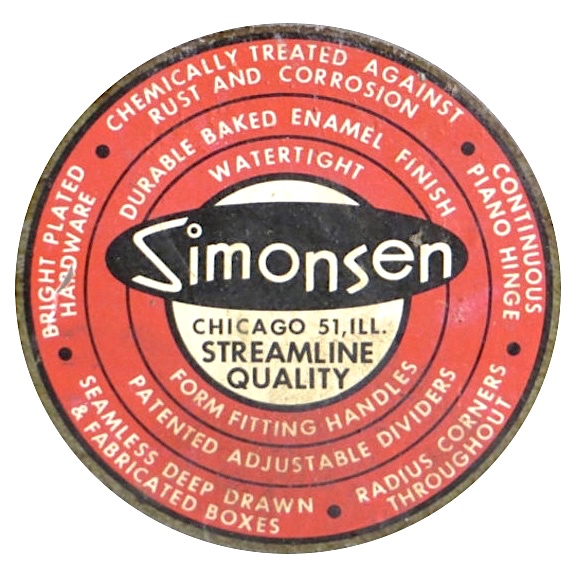 In the machine shop, Simonsen showed a knack not only for metalwork, but for invention. His creations pulled in a number of patents for the R.M. Eddy Foundry Co., ranging from a new breed of wrench to a stronger style of brake shoes. The latter product was eventually purchased by the Chrysler Corporation.
In the machine shop, Simonsen showed a knack not only for metalwork, but for invention. His creations pulled in a number of patents for the R.M. Eddy Foundry Co., ranging from a new breed of wrench to a stronger style of brake shoes. The latter product was eventually purchased by the Chrysler Corporation.
And so, by the dawning of the Great Depression, the Simonsens had at least enough financial security to purchase a new home at 2201 N. Nagle Ave. in the Belmont Central neighborhood on the west side. This is where Ed and Ethel lived for the next decade and beyond, eating meals, sleeping in a bed, and arguing (presumably) about money—all the usual. Somebody else is living there today, unwittingly walking in the footsteps of Chicago industrial greatness.
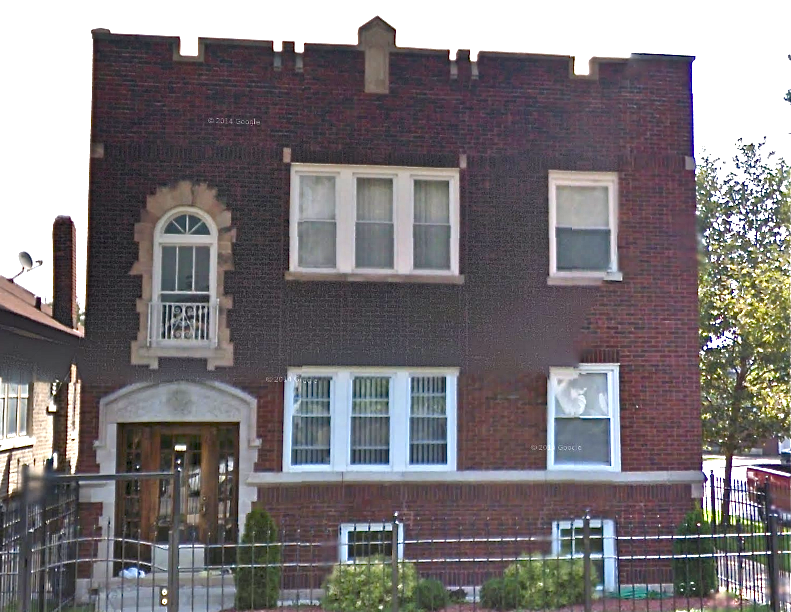 [The former Edward Simonsen “estate” at 2201 N. Nagle Avenue]
[The former Edward Simonsen “estate” at 2201 N. Nagle Avenue]
Anyway, the best American Dream stories have to include an obligatory dose of ambition, and Edward Simonsen did, indeed, see greater potential for himself. Just shy of his 50th birthday, he founded the Simonsen Metal Products Company and purchased factory space at 4444 W. Chicago Ave—a building that has managed to survive to the present day, most recently occupied by a direct-mail company.
During his days at the R.M. Eddy foundry, Simonsen had been encouraged to think outside the box, and it had benefited his bosses nicely. Now, his inventions would be assigned to his own company, and rather than thinking outside the box, he could start re-thinking the box itself.
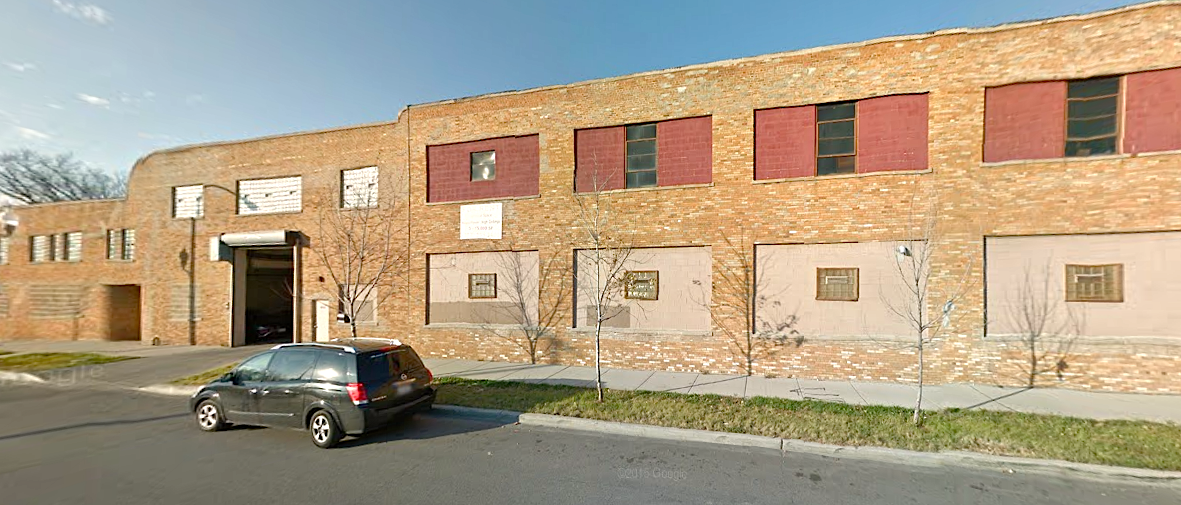 [Above: The former Simonsen Metal Products factory at 4444 W. Chicago Ave.]
[Above: The former Simonsen Metal Products factory at 4444 W. Chicago Ave.]
[Below: A newspaper ad seeking surface grinders for the plant, 1948]

Through the 1940s and ‘50s on through Edward’s death in 1966, Simonsen Metal was a leading national name in quality toolboxes and tackle boxes, with some side work in industrial storage cabinets and film containers. The company employed a team of 200 workers during its postwar heyday in the early 1950s, and also operated a mail order wing known as Simonsen Industries, Inc., with offices at 1414 S. Michigan Avenue.
Simonsen had several different logos over the decades, but its most memorable—as seen on the toolbox from our museum collection—featured an illustrated spaniel dog named “Niki” and the words “TACKLE * TOOL * BOND * FILM – BOXES OF QUALITY.” It’s kind of funny that they chose that series of words just a little before “Bond Film” became a genre of cinematic spy thrillers.
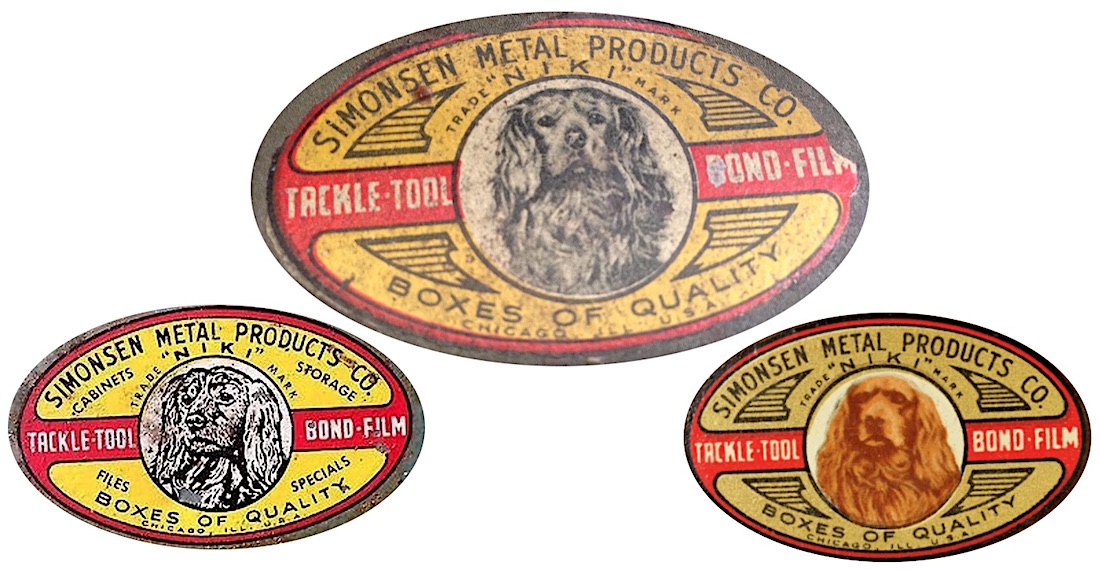 [Simonsen’s “NIKI” trademark, as seen on our museum tackle box (top), was one of several versions over the years, evidenced by the two alternative labels to the left and right]
[Simonsen’s “NIKI” trademark, as seen on our museum tackle box (top), was one of several versions over the years, evidenced by the two alternative labels to the left and right]
“Niki” was, according to Edward Simonsen’s own grand-nephew, the actual family dog. I don’t have additional information as to what made Niki so beloved as to become logo-worthy. But I can certainly conjure up a dramatized origin story in which Edward and Ethel step out their front door on Nagle Avenue one dreary Chicago evening to find a sad, rain-soaked spaniel pup sitting there on the doorstep. They give him the solid Danish name Niki and raise him into a prize-winning show pooch. Ed Simonsen even brings Niki over to the metal factory sometimes to give the boys a welcome distraction. “Ed loves that dog even more than making toolboxes,” a generic Simonsen employee never said.
Dog legends aside, we do have evidence that Edward Simonsen was still actively plying his trade well into his 60s. In 1957, he picked up a patent, shown below, for a new type of toolbox tray with moveable compartments.
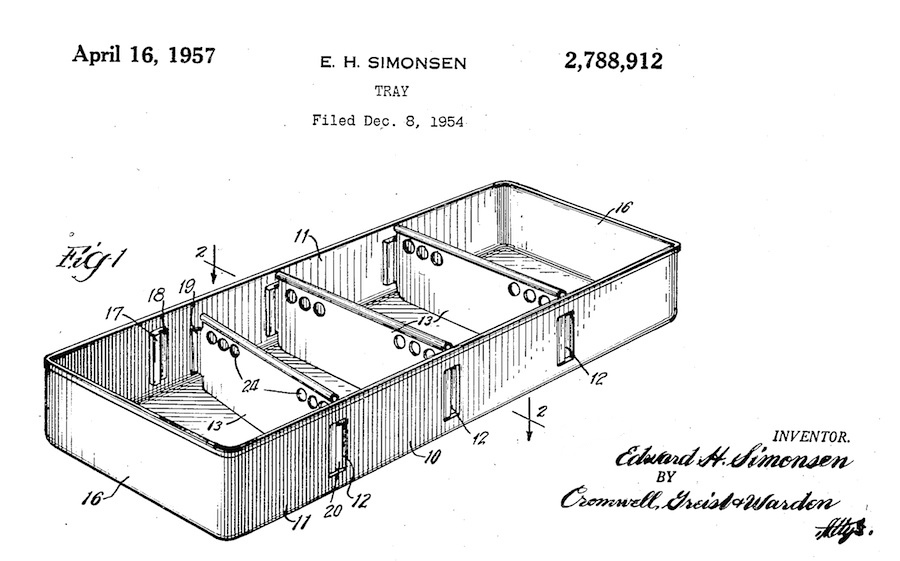
Our museum toolbox / tackle box looks like an earlier, less customizable model, as the individual tray compartments can’t be adjusted. The tray does function on a pretty cool pop-out hinge system, though, for maximum space efficiency.
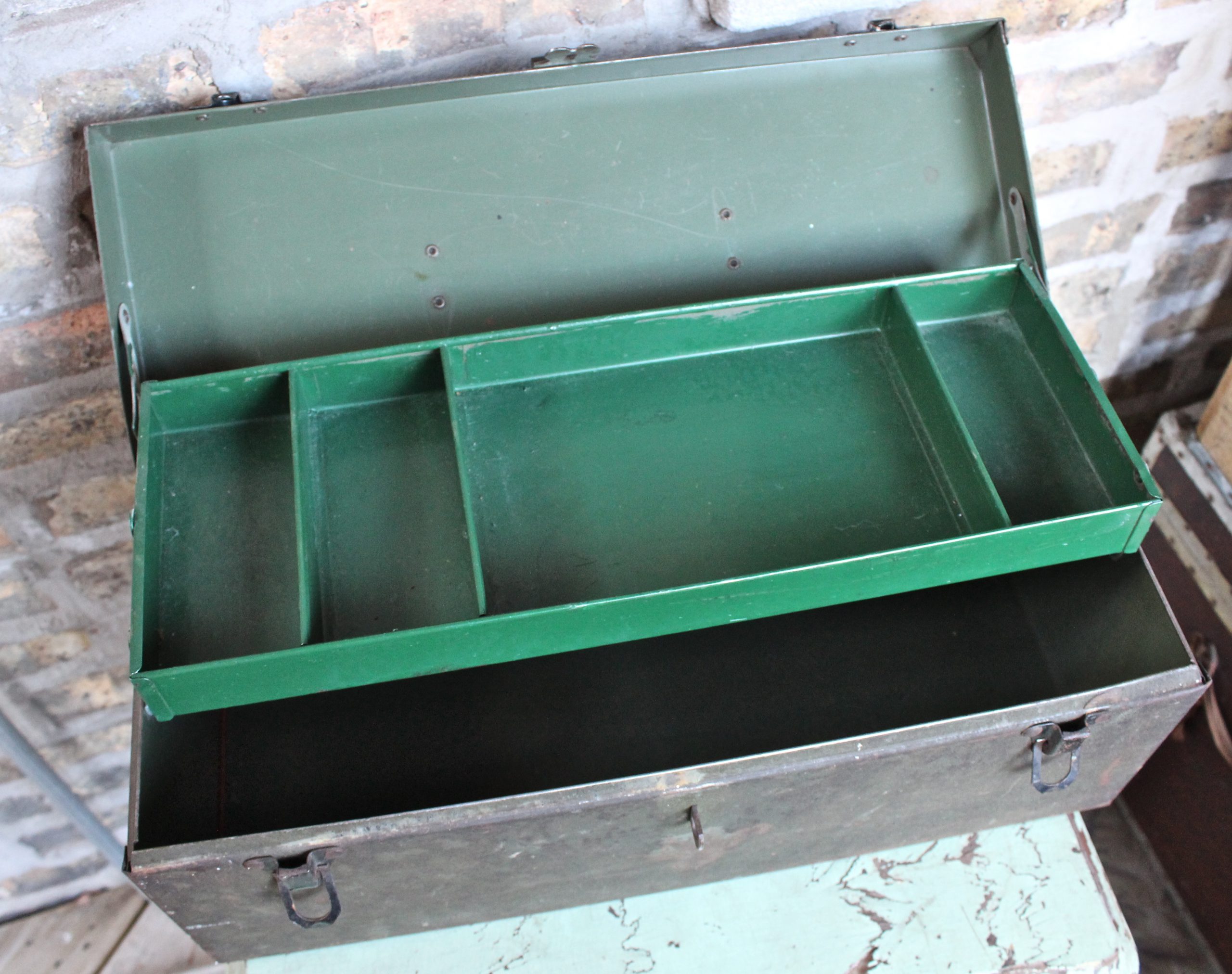
In the golden age of white-t-shirt-wearing dads walking around suburbia with either a toolbox, a tackle box, or both, Simonsen thrived. Their ads appeared in regional newspapers across the country, and the quality construction of their products made them good hand-me downs from the Greatest Generation to the Baby Boomers to Gen X.
The Chicago Avenue factory, meanwhile, was part of a growing “scene” of machine tool shops and other like-minded manufacturers. According to Anthony Dzik’s book Pillars of Kedvale Avenue, by the early ‘60s, Simonsen could count F&B Manufacturing, Endure Tool and Engineering, and Simplomatic Metal Stampings among its neighbors. The same stretch of Chicago Ave. was also home to the Hawthorn Melody Dairy and Burney Brothers Bakeries.
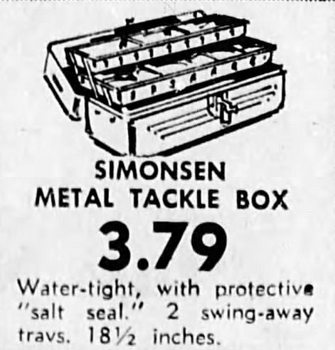 According to Edward Simonsen’s grand-nephew Bob, the business was reluctantly sold to Sears/Craftsman shortly before Edward’s death in 1966. From there, the name seemed to survive as a Craftsman subsidiary for a while until finally fading into obscurity and out of circulation by the 1980s.
According to Edward Simonsen’s grand-nephew Bob, the business was reluctantly sold to Sears/Craftsman shortly before Edward’s death in 1966. From there, the name seemed to survive as a Craftsman subsidiary for a while until finally fading into obscurity and out of circulation by the 1980s.
Perhaps you’re thinking to yourself, “I bet Simonsen would still be around today if they’d used the obvious tagline: Simon Says, Simonsen!” And I agree with you whole-heartedly.
If you have more information about Simonsen Metal, particular if you worked for the company or know someone who did, please contact us and help us fill in the blanks.
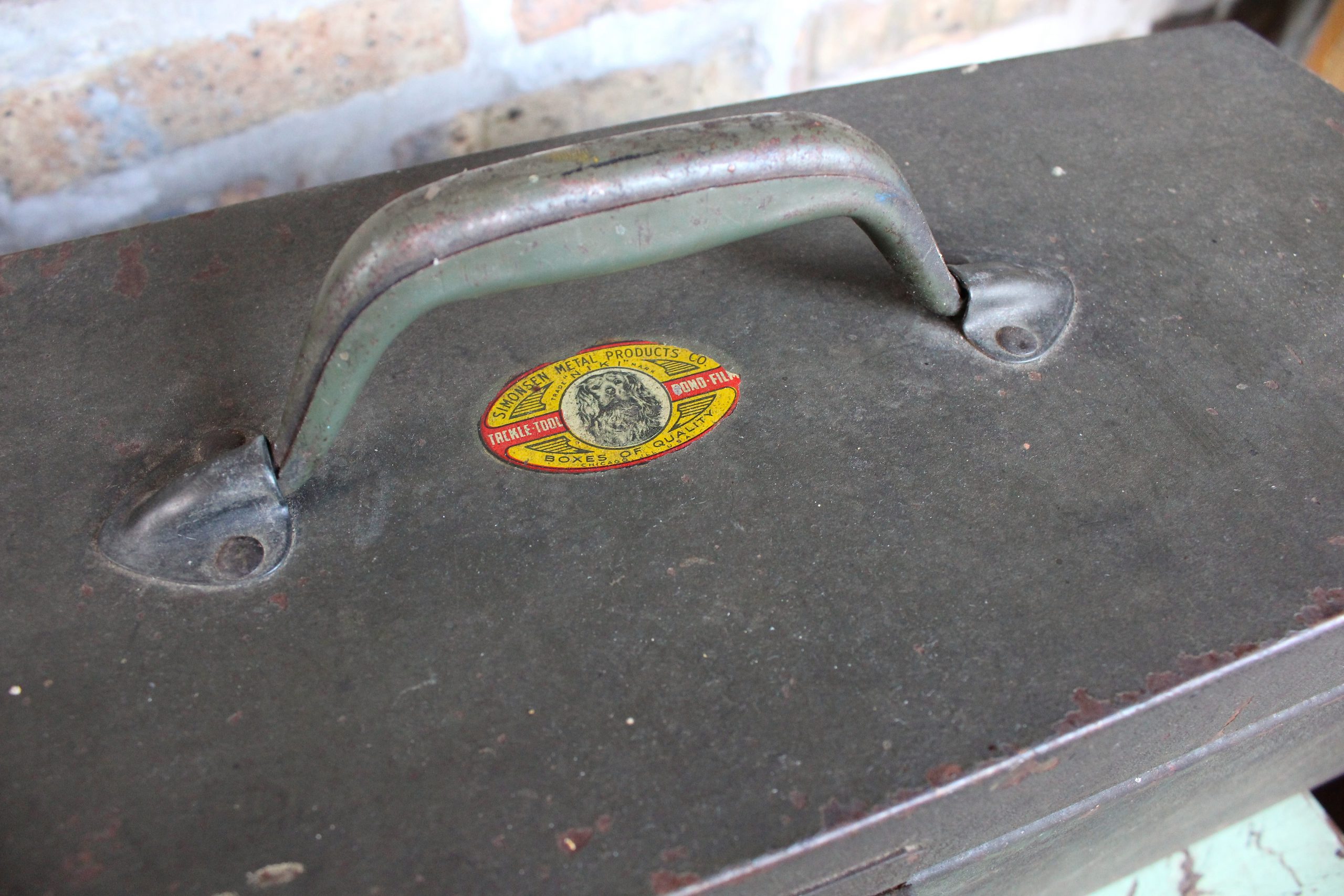
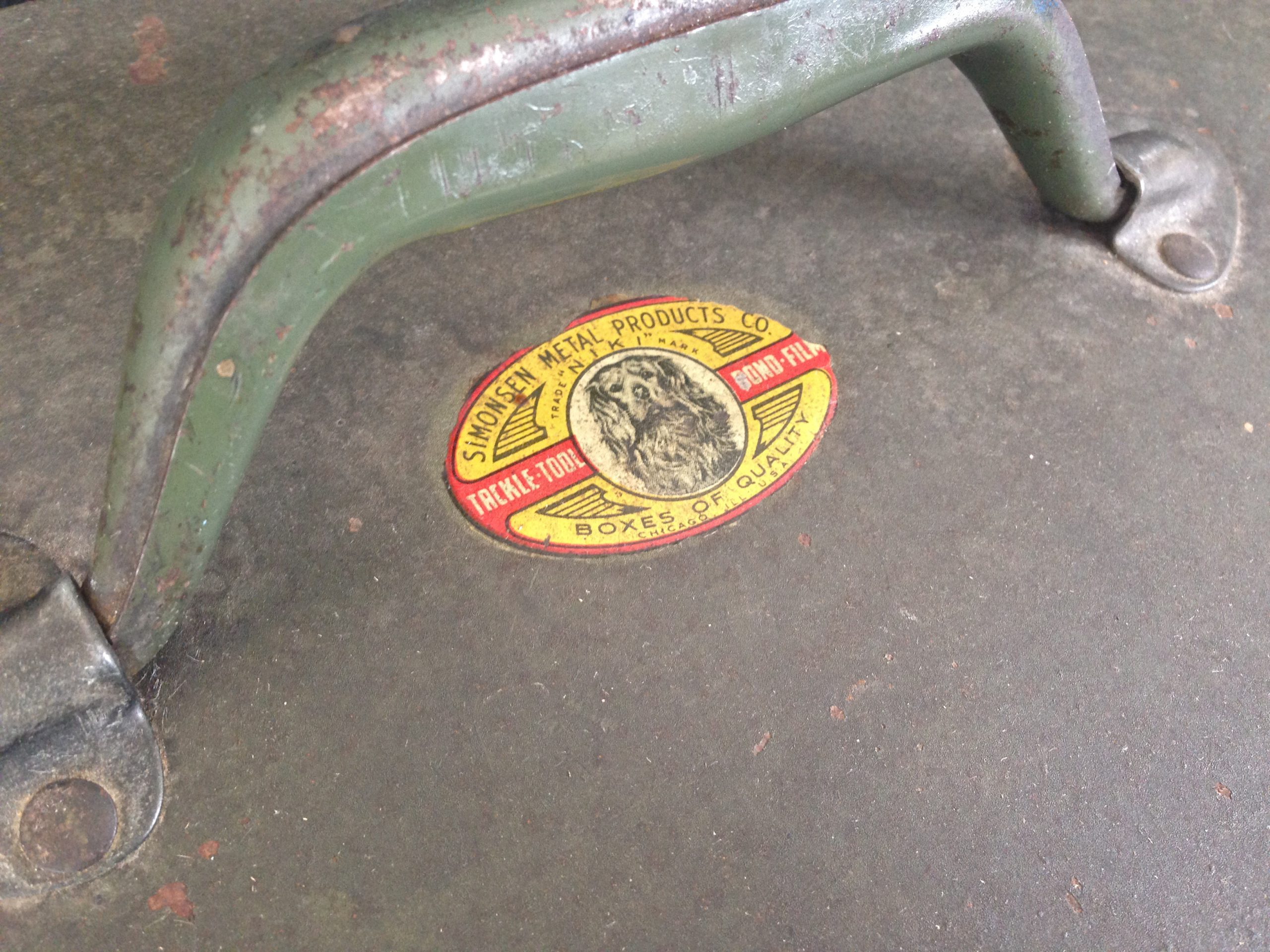
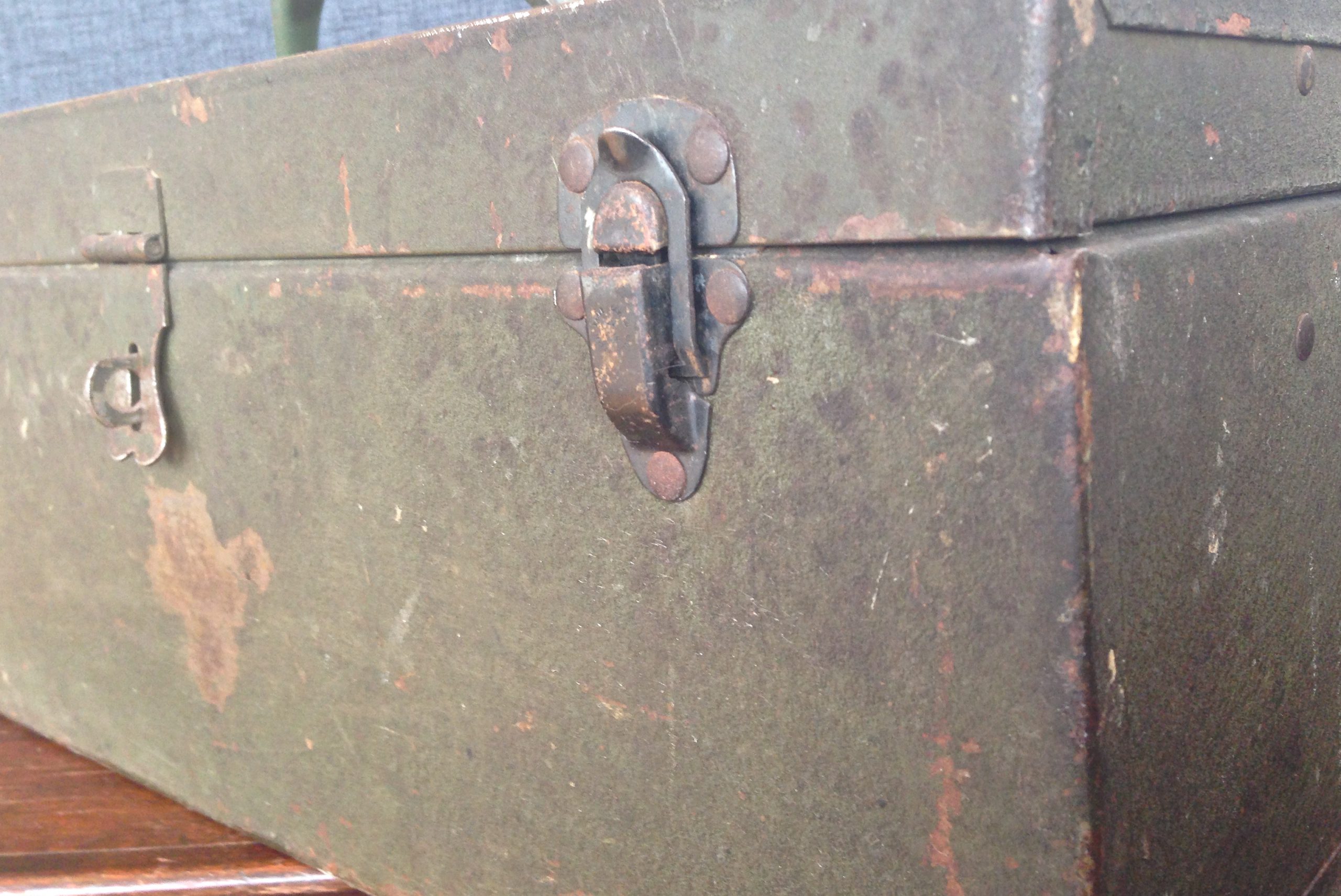
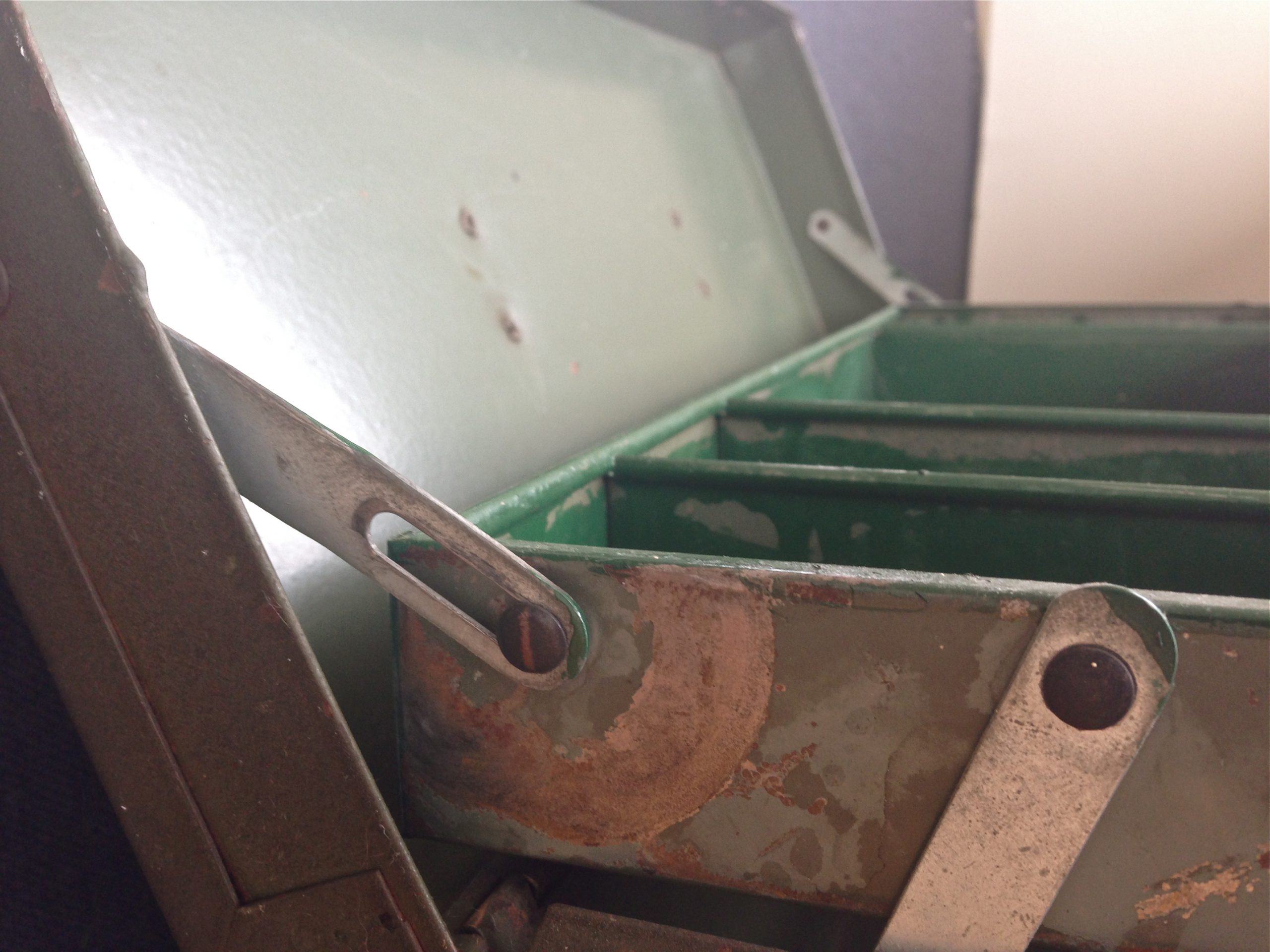
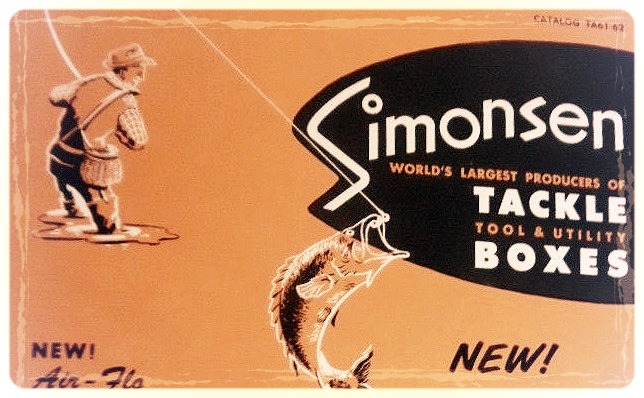
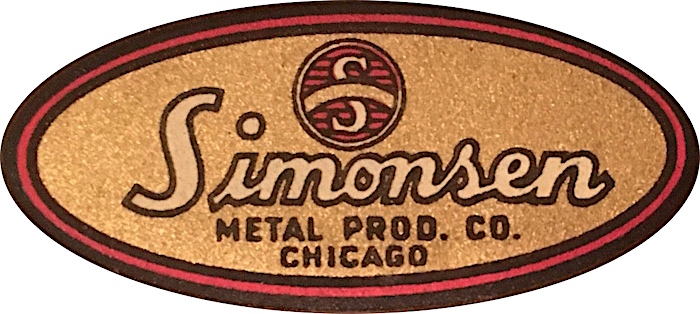
Archived Reader Comments:
“Awesome article. I recently acquired a roof top canteliever toolbox. It has KUHF USS 33579191 on it. I think it was a military issue box. If you have any more info I would really appreciate it.” —Amy Richardson, 2019
“I was just about to spray paint an old rusty green tackle box that was my Grandpa’s ( he loved to fish, died in 1973,) but decided to take a close look at the label first because it definitely had the look of a former era. So happy to find out about Simonsen and the museum! And so glad I didn’t spray paint this piece of history. It actually survived Hurricane Katrina!” —Jan Clements, 2018
“Was issued several Simonsen gable top tool boxes during my Time in the USAF. A solid, well built box, served me well.” —B. Samm, 2017
“It it’s from my understanding that Edward sold his company to Sears/Craftsman back in the 60’s.Niki was their beloved dog.I’ve was told by my late grandmother that he also was the one that created the piano type hinge for the toolbox.Edward was my Grandfather’s brother.” –-Bill S., 2017

My grandfather’s tool box has the Simonsen logo but no dog. Can anyone date it?
Hi I am an Air Force Vietnam war veteran,served as a B-52 jet engine mechanic from 1969 to 1975. I am trying to find out which tool box was issued by the Air Force during that time. I am almost certain that it was a Sorensen 21” or 22”. One thing for sure that tool box never let me down. It was full all kind of tools that any backyard mechanic would love to have. Weighing a whooping 120 pounds of tools I carried it with me during 6 years.
I am 77 now and I would like to know any information that you can give regarding which tool box was issued.
HI – I AM AN 80 YEAR OLD VIETNAM VETERAN – I WAS STATIONED AT FORT SHERIDAN
IL IN THE EARLY 60’S. ALOT HAPPENED DURING THAT PERIOD = I MARRIED MY WIFE
IRIS – WE HAD OUR FIRST CHILD – RHONDA = AND I PURCHASED A TOOL BOX TO KEEP IN MY OLD 1951 NASH RAMBLER. (GOD KNOWS I NEEDED IT). WELL – LONG
STORY SHORT – I JUST OPEND THAT BOX TO GET A FEW TOOLS OUT. IT IS STILL
SOLID AS A ROCK =- A LITTLE RUSTY – YES – HANDLE / CLASP/ BOX/ NEVER FAILED.
THE ORIGINAL STICKER STILL ON FRONT TOP UNDER HANDLE.
‘.WE JUST CELEBRATED OUR 60 TH ANNIVERSARY AND SOON MY DAUGHTER’S 60 TH BIRTHDAY. ( NOT TO MENTION THE TOOL BOX’S 60 TH ANNIVERSARY. )
GOD BLESS AMERICA = GOD BLESS US ALL = STAY WELL !!!!!
Great website. I have my grandfather’s Simonsen Industries toolbox. Two-trays and two hasps. No dog on it though. It has a sticker that says “Mike,” with a boxer on it. It also has the tag line: “the line with a punch” and says “Steel Tackle Tool Bond Film Boxes.” Do you have any further information on this model?
I have a Simonsen box that holds 6 200 foot reels of 8mm movie film. Let me know if the museum would be interested in having this item. I can send a photo if you want.
My husband is a distant relative of Edward Simonsen. His grandfather, Alfred Simonsen was Edward’s brother. I think it would be neat to purchase a Simonsen tool box as a gift for my husband. To the collector’s out there, what are some features that I should look for?
Anyway I can get a time line of the “tool caddy” I’ve ever ever seen what it looked like new only dented missing pieces multi colored paint brushed shag carpeted metal messes..lol. the one I’m trying to but tomorrow is similar to the one I have but I think it’s older..more square where mine is rounded. .it would be cool to post pics on here
I’ve just finished refurbishing a tool caddy to my own liking as far as paint but original as I can tell with very little to compare to online I absolutely love it and actually found another one tonight just before researching again when I stumbled across this. I’d love to post it for everyone it’s a super sweet tool cart I think
Ed was my great uncle.. Ethel was my grandfathers sister…Was so happy to see this story.My father passed away in 98..Dad worked for his uncle Ed back in the 40’s.. According to my dad, the factory also made parts for planes etc during WW II..This was so interesting.. thanks for posting
I recently (via a pic) obtained an old metal tool box; it has a “raised” Eagle Wing logo on it. Is this, did Simonsen use the “Eagle Wing” logo on their metal tool boxes?
hello just getting into collecting Simonsen boxs, i sure would like to see a photo of your military box as mentioned. Thanks Ray lockport ill drainray1@gmail.com
I have a simonsen metal tool box made for military use during the war to military specifications under US contract. How do I enclose a photo of it on this site
Just cleaning up dad’s old Simonsen Type 2 Class1 Gov’t Contract tool box. It has gold paint on it and doesn’t appear to have had any other paint beneath/before. As a military contract toolbox would it have been produced with gold paint ?
My father, Elmer Byrne, worked at Simonsen’s for a period during the 40s and 50s. Not sure about the dates. He took me to the shop a number of times. I think he said he was a tool crib attendant, if that makes any sense. We lived at 1622 W Belmont, not far from Mr. Simonsen’s home.
Jim Licquia (formerly Byrne)
1622 W Belmont was clear on the other side of the city from Simonsen’s home…8 miles and over 30 minutes away.
I have a Simonsen tackle box that seems to be unique, because of all the pics posted here and on EBay, they all seem to be painted steel. Mine is aluminum. Also, it is the kind of tackle box that opens in 2 directions, each side having that typical extra tray that opens out of the way, but being accessible while also opening up to the now accessible bottom of the box.
I am glad I did this research and learned about the company. My tackle box looked old, but I did not know if the company still existed, or how old mine might be.
There is a small decal on it, but it does not look like the ones on this web page. Mine is relatively small, rectangular, with gold border / blue field / with gold lettering stating “Simonsen” on top with “Chicago Illinois” underneath, in that blue field.
The box seems very well made and operated ( hinges and moving trays ) very well.
About the history you provided, I find it interesting that Sears thought enough of the company products, to buy the company. You mention that something slowly faded away though. I am curious if Simonsen made tool boxes for Sears under contract, displaying a ‘Craftsman’ label maybe, prior to the buy out. Then, if so, Sears could just continue with the ‘Craftsman’ boxes. If all that was not the case, after the sale, did Sears market the boxes with a Simonsen or Craftsman label ?
Does the decal on my tackle box, and the fact that it is aluminum, help to date it ?
Did they only make aluminum boxes in the early days, or only later, or what ?
Did my decal design get replaced by the one you note in your post, thus, inferring a date range of when mine might have been made ?
One more feature is the “thunderbird-like” design embossed into the aluminum on all 4 sides of the box. That design on the front and back long sides of the box is slightly different than what appears on the shorter 2 ends of the box.
Jim
ps. I like collecting in general, and like unique and / or valuable things. But, I am not a fisherman, per se ( I am not retired yet ) I would be interested in selling this box to someone who could display it or ‘cherish’ it better. I do not have many modern, high tech devices but could text a pic of the box with my flip phone if someone wanted to contact me at 614-314-4911
I have a metal box that is a spring assortment. It is marked Mechanics choice and has 100 springs. Made by Simonsen Ind Inc. Chicago 51, Ill
It is green in color.
I consider it a treasure!
Jim,
“I think he said he was a tool crib attendant, if that makes any sense.”
That makes perfect sense.
This was a position of competence, trust and accountability both for the factory managers as well as the workers. The person doing it had to be diligent all the time.
Many larger maintenance facilities still use such a system though it would be computerized today.
A larger shop or factory like Simonsen would have a locked tool storage area that was run like a lending library.
Everyone would have their own tools for the normal jobs they did, but checked out tools not normally used.
The Tool Crib was where certain tools and tooling would be kept that wasn’t normally used by anyone all the time / everyday.
Also, certain expensive tools were kept there as well as consumables and tooling like drill bits, milling cutters and the like.
The attendant would generally log the user in and the tool out and the reverse when the tool was brought back.
Many shops issued name/number tags to workers that would be hung on a board where the tool would be stored for quick reference to where it could be located. Some also would log tools and users into a log book.
In most places this would earn extra pay and/ or benefits as well.
I was wondering if I could get a reproduction or something to redo a simonsen tool box. I need the logo sticker.
You definitely can, if you get a clear scan of a logo you can have one done up.